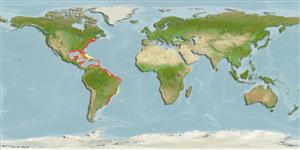>
Anguilliformes (Eels and morays) >
Ophichthidae (Snake eels) > Ophichthinae
Etymology: Ophichthus: Greek, ophis = serpent + Greek, ichthys = fish (Ref. 45335); gomesii: Named for Ildefonso Gomes, a physician who treated Castelnau of a sickness in Rio de Haneiro; noun in genetive case (Ref. 54133).
Eponymy: Dr Antônio Ildefonso Gomes de Freitas (1794–1859) was a physician and botanist in Rio de Janeiro whom Castelnau (q. [...] (Ref. 128868), visit book page.
More on author: Castelnau.
Environment: milieu / climate zone / rango de profundidad / distribution range
Ecología
marino demersal; rango de profundidad 1 - 450 m (Ref. 57911), usually 1 - 90 m (Ref. 57911). Tropical; 44°N - 36°S, 98°W - 34°W
Western Atlantic: Massachusetts, USA and northern Gulf of Mexico to southern Brazil; absent in the Bahamas and most Caribbean islands. Northwest Atlantic: Canada (Ref. 5951).
Tamaño / Peso / Age
Madurez: Lm ? range ? - ? cm
Max length : 91.4 cm TL macho / no sexado; (Ref. 26340); common length : 50.0 cm TL macho / no sexado; (Ref. 3795)
Inhabits soft bottoms. Occurs in bays and backwaters to offshore banks, less commonly to 180 m depth. The most common eel on Florida shrimp grounds. Rarely consumed (Ref. 3795).
Life cycle and mating behavior
Madurez | Reproducción | Puesta | Huevos | Fecundidad | Larva
Robins, C.R. and G.C. Ray, 1986. A field guide to Atlantic coast fishes of North America. Houghton Mifflin Company, Boston, U.S.A. 354 p. (Ref. 7251)
IUCN Red List Status (Ref. 130435: Version 2025-1)
Threat to humans
Harmless
Human uses
Pesquerías: sin interés
Herramientas
Special reports
Download XML
Fuentes de Internet
Estimates based on models
Preferred temperature (Referencia
123201): 12.4 - 27.8, mean 24.8 °C (based on 1328 cells).
Phylogenetic diversity index (Referencia
82804): PD
50 = 0.5000 [Uniqueness, from 0.5 = low to 2.0 = high].
Bayesian length-weight: a=0.00091 (0.00039 - 0.00215), b=2.99 (2.79 - 3.19), in cm total length, based on LWR estimates for this (Sub)family-body shape (Ref.
93245).
Nivel trófico (Referencia
69278): 4.0 ±0.7 se; based on size and trophs of closest relatives
Resiliencia (Referencia
120179): Medio, población duplicada en un tiempo mínimo de 1.4-4.4 años (Preliminary K or Fecundity.).
Fishing Vulnerability (Ref.
59153): High vulnerability (57 of 100).
🛈
